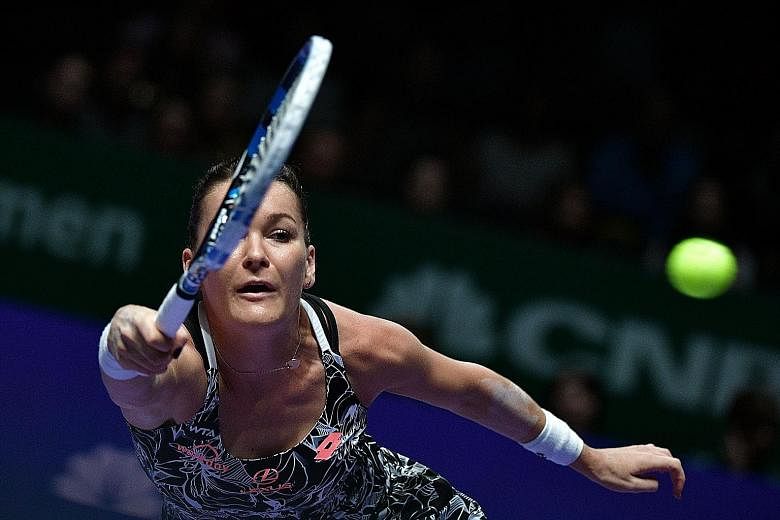If you want to know about touch in sport it's best to speak to a woman with a degree in conjuring. Martina Hingis, Swiss and subtle, thinks and says: "Touch is to be able to do anything you want with a ball. Out of defence to hit a drop shot. Or place the ball wherever you want."
Touch is casual invention, an array of shots and sport made to look like it's unbearably easy. Touch is the subject on Friday because Poland's Agnieszka Radwanska is playing. This could be fun.
In the old days, the late Arthur Ashe, writing in The Washington Post, stated that "(Ilie Nastase) has almost the artistry of Michelangelo". Radwanska is not in that class of talent, but if you wait long enough she might play a shot that calls for an art critic to be present.
It takes a while, 10 games to be precise, and then it comes. A one-handed, half-volley backhand flick on the baseline from a two-handed player. Almost Federer-ish. In the same game she punches an angled forehand volley and stretches to hit a running backhand deep to break.
Control. Variety. Range.
Thank you.
 Agnieszka Radwanska of Poland in action against Karolina Pliskova of the Czech Republic yesterday. Radwanska won 7-5, 6-3 to advance to the quarter-finals, where she will meet world No. 1 Angelique Kerber of Germany. ST PHOTO: MARK CHEONG
Agnieszka Radwanska of Poland in action against Karolina Pliskova of the Czech Republic yesterday. Radwanska won 7-5, 6-3 to advance to the quarter-finals, where she will meet world No. 1 Angelique Kerber of Germany. ST PHOTO: MARK CHEONG
Radwanska is hardly the best player in tennis but elicits descriptions that better players may not earn. On Thursday, coach Wim Fissette, former tutor to Kim Clijsters and Victoria Azarenka, says: "She has unbelievable touch. She knows exactly what to do to win a point. She will play tennis like a chess game and always makes right choices."
Yesterday I ask Chris Evert, who is 18 Grand Slam titles wise, and she says about Radwanska: "She's one of a kind. Just the variety of shots. She can carve, she can slice, she can come up with different kinds of spins that we don't see in the women's game, she can improvise, she can hit shots on her knees, she makes some unbelievable gets, she's so unpredictable."
It's fair to say the slight Pole can be a big problem.
Of course, yesterday is not the greatest advertisement for touch because for great swathes of the match it's all about Karolina Pliskova's (mis)use of power. The Czech's powerful forehand collides with the ball like a right hook. Bang. The ball either goes in or out. She is explosive, then she implodes with 29 unforced errors. Radwanska had eight.
Radwanska hangs around, she does enough, she wins 7-5, 6-3. It's not as much fun as we expect, but we will take anything we get from the Pole. A drop shot on the fourth point of the match (even if it doesn't work). Occasional wrong-footers. Forehand slice. Backhand slice. It's not the result really that matters, it's the style we're cheering for.
Because touch is going out of fashion, it is being muscled out of sport. This is the bare-knuckle MMA generation of hit and bleed, this is the era when we get turned on by Rory McIlroy driving it 330 yards in the air. People who want subtlety are advised to visit an art gallery.
Evert, from a less muscular generation, says: "It's such a power game now. Everybody feels that they've got to hit the cover off the ball to win a point. Look at Madison Keys, Pliskova, Serena, Maria Sharapova. They're all power." Radwanska has none, so she must learn touch.
Sport as savagery has a visceral thrill and a gasp goes up when a ball is blistered down the line. Yet touch will always have its own, little place in sport. A bit like the poetry section in a large bookshop full of prose.
Golfers, for instance, will always need touch around the greens and when Phil Mickelson plays those brilliant flop shots it seems he buys his clubs from Hocus Pocus. They sell magic items. Cricketers still use soft hands to play delicate strokes and footballers exhibit fine feel when they collapse 40-metre curling passes with a touch of their boot.
Touch looks innate, as if it's too beautiful to be learnt, but Hingis warns against romanticising it. "It doesn't fall from heaven," she says, but is polished, like any craft, by hitting "millions of balls". Drop shots are built of imagination and also sweat.
Touch is what Radwanska will certainly require today, for Angelique Kerber will demand consistent invention from her. She will need to bring her cool, her intelligence, her inspiration, her footwork. The last quality at least should not be an issue. After all, as the Pole told me last Sunday, when she was young she loved hip-hop and breakdance.


